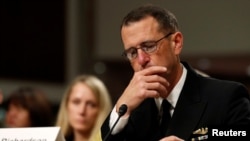The U.S. Navy is blaming the high pace of operations, budget uncertainty and naval leaders who put their mission over safety after multiple deadly incidents at sea.
The destroyer USS John S. McCain collided with an oil tanker last month off the coast of Singapore, leaving 10 U.S. sailors dead and five injured. And the USS Fitzgerald, another destroyer, collided with a container ship in waters off Japan in June, killing seven sailors.
The collisions are still under investigation, but at a Senate Armed Services Committee hearing Tuesday, the chief naval officer, Admiral John Richardson, said a failure of leadership throughout the service was the main contributing factor in the Navy's lack of readiness.
"I own this problem," Richardson testified.
He vowed to make safety the most important goal of the Navy in the wake of recent events, acknowledging that commanders of vessels on forward deployments too often put the mission first, at the expense of safety.
"Only with those [safety certifications] done and the maintenance properly done can we expect to deploy effectively and execute the mission," he said.
At the start of Tuesday's committee hearing, U.S. Senator John McCain extended his "deepest condolences" on behalf of all Americans to the family members of those killed, some of whom sat in the hearing room. The USS John S. McCain was named in honor of the Arizona Republican's father and grandfather, both of whom were Navy admirals.
Longer hours
John Pendleton, an expert on defense readiness issues with the Government Accountability Office, told lawmakers reductions in ship crew sizes had led to longer working hours for sailors — up to 100 hours per week in some cases.
Pendleton said he was skeptical that the Navy would be able to increase readiness until aggressive deployment schedules and other demands on the force were decreased.
Richardson said the Navy was closely investigating sleep deprivation among crews, causing McCain, the chairman of the committee, to question why the Navy was not making immediate changes.
"I think I know what 100 hours a week does to people over time," McCain said. "I'm not sure you need a study on it."
Richardson also warned that the increased deployment tempo frequently leaves sailors with insufficient time to prepare for missions, and it leaves the Navy with too few vessels. According to the Navy, the service has been trying to fulfill duties that require more than 350 ships with only about 275 ships available.
Secretary of the Navy Richard Spencer likened the situation to a balloon that has been filled with too much air and cannot be stretched any further.
"If you squeeze it, it pops," he said.
There have been two additional Navy incidents in the Pacific region this year.
The USS Antietam ran aground near Yosuka, Japan, in January, and the USS Champlain collided with a South Korean fishing vessel in May.










